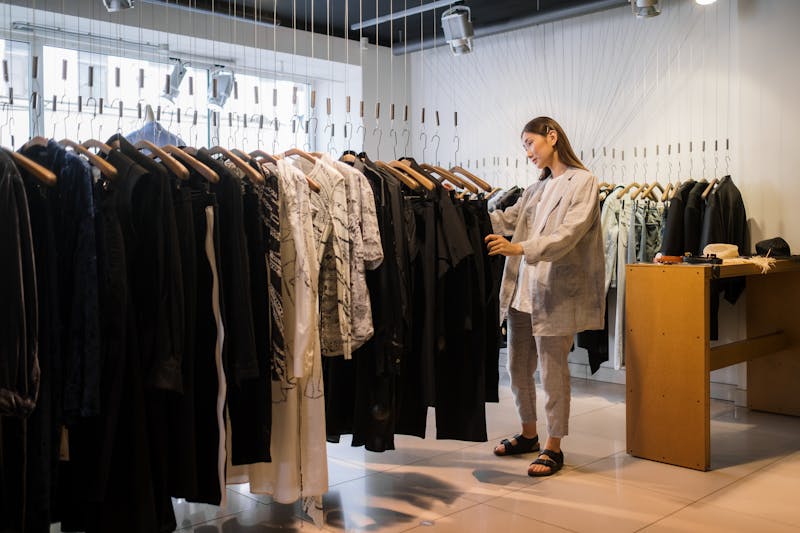The Creative Journey of Designers
Fashion design is not just about creating beautiful garments—it’s a deeply creative process, often inspired by the world around the designer. For top designers, inspiration can come from a variety of unexpected places: nature, history, art, technology, and even personal experiences. This article takes you behind the seams to explore where some of the most influential designers find their creative sparks and how they translate those inspirations into the next big trend.
1. The Art of Observation: Inspiration from the World Around Us
Designers are exceptional observers—they don’t just look at things; they see them through a creative lens, picking up on patterns, colors, and textures that others might miss. From nature to architecture, many sources serve as endless wells of inspiration.
Nature: The Most Constant Muse
One of the most common sources of inspiration for designers is the natural world. The colors, shapes, and textures of flowers, landscapes, and even the changing seasons offer endless creative possibilities. Designers often reference nature in their fabric choices, prints, and even the silhouettes of their garments. For instance, floral patterns or earthy tones often reflect the beauty of the environment, while flowing fabrics mimic the graceful movement of water or wind.
Architecture: Blending Structure with Style
Architecture is another key source of inspiration. The clean lines, proportions, and geometrical structures found in buildings often inspire the cuts and shapes seen on the runway. Think of the sharp angles in skyscrapers influencing modern tailoring or the curves in Gothic architecture inspiring organic, fluid silhouettes. Designers often find the way a building is constructed—how space is used and light is manipulated—to be a fascinating source of design ideas.
Street Style: Real Life as the Ultimate Catwalk
Street style has become an increasingly significant influence on fashion design. The unique, unfiltered creativity seen on the streets provides designers with an authentic view of how fashion interacts with real life. It’s no longer just about runway looks; it’s about how people are mixing and matching pieces in their everyday lives. Street style is an untapped goldmine for designers who want to create clothing that resonates with their audience in an authentic way.
2. Cultural and Historical References in Fashion Design
Many designers draw from a rich tapestry of cultural and historical influences to create designs that speak to both the past and the present. Fashion has always been intertwined with culture, reflecting the values, aesthetics, and struggles of different societies.
The Influence of Global Heritage
Global heritage plays a significant role in shaping the designs of many fashion houses. Designers often travel or look to other cultures for fresh ideas. From African textiles to Asian embroidery techniques, traditional crafts and styles are continually incorporated into modern collections. These cultural references offer a sense of timelessness, bringing diverse elements into the contemporary fashion landscape.
Revisiting Past Eras: Nostalgia and Innovation
Nostalgia is another common inspiration for designers. Vintage styles from past decades—whether it’s the elegance of the 1920s flapper dresses or the bold prints of the ’70s—offer designers a wealth of inspiration. Designers reimagine these past trends, making them relevant for today’s audience, creating a fusion of history and modernity. This balance of nostalgia and innovation is often what makes certain collections stand the test of time.
3. Fashion Shows and Runway Moments: Inspiration from the Spotlight
Fashion shows are not only platforms for showcasing new collections—they’re also places where designers draw inspiration from the performances themselves. The energy, the models, and the spectacle of the runway can spark new ideas.
The Collaborative Spirit of Fashion Weeks
Fashion weeks around the world are filled with collaborations between designers, stylists, and artists. These moments of creative collaboration often inspire bold, unexpected collections that push the boundaries of what fashion can do. The energy and excitement of the runway can be a catalyst for new ideas, often seen in collections that challenge traditional fashion concepts.
The Role of Performance in Fashion
The performance element of fashion shows is not to be underestimated. The way a designer presents their collection, through movement, sound, and lighting, is often just as impactful as the garments themselves. This theatrical approach can help designers experiment with new ideas, pushing them to create pieces that are not only visually stunning but also deeply expressive.
4. The Impact of Art and Music on Fashion Design
Art and music have always influenced fashion. These creative realms intersect in ways that allow designers to tell stories through their collections, using visuals and sounds to communicate deeper meanings.
The Intersection of Fashion and Visual Art
Many designers look to fine art for inspiration. From abstract paintings to sculptures, visual art informs the colors, textures, and forms used in fashion. For example, the fluid brushstrokes of a painting might inspire flowing fabrics, while the color palette of an artist’s work can directly influence a collection’s tones and hues.
Music Icons: Designers Draw Inspiration from Sound
Music icons have long been a source of inspiration for fashion designers. The rebellious spirit of rock and roll or the sleek sophistication of jazz influences collections that tap into the emotion and attitude of specific musical movements. Designers often channel the energy of musical genres into their collections, translating that sound into fabric, form, and design.
5. Technology and Innovation: The Future of Design Inspiration
As technology advances, it has become an increasingly important source of inspiration in the fashion industry. Digital tools, new materials, and innovative design techniques are helping designers push the boundaries of creativity.
Digital Design and Virtual Reality in Fashion
Virtual reality (VR) and digital design software have revolutionized how designers conceptualize their collections. VR allows designers to experiment with virtual garments and runway shows before ever creating a physical sample. This technological leap has opened up new possibilities for interactive and immersive fashion experiences, giving designers access to an entirely new form of inspiration.
Sustainable Fashion and Eco-Innovation
Sustainability has become a significant focus in the fashion industry, and many designers are drawing inspiration from nature and technology to create eco-friendly garments. Innovative fabrics made from recycled materials, plant-based dyes, and zero-waste designs are just a few examples of how sustainability is shaping modern fashion.
6. Personal Experiences and Emotional Connections
For many designers, the most profound source of inspiration comes from within. Personal experiences, emotions, and memories can deeply influence their designs.
Designers’ Unique Stories and Personal Struggles
A designer’s personal history and struggles can often be found in their work. Whether it’s a difficult childhood, a life-changing event, or a personal journey, these experiences are woven into the designs, making them deeply personal and often powerful. This connection to the work adds a layer of authenticity that resonates with audiences on a deeper level.
The Power of Emotion in Fashion Design
Emotions like love, loss, or joy can drive the creative process, transforming raw feelings into tangible designs. Designers often use fashion to express what words cannot, telling stories of struggle, triumph, and celebration through their garments.
7. Collaborations and Cross-Disciplinary Influence
Collaboration has become a major source of inspiration in fashion. By working with artists, musicians, or even other designers, a new wave of creativity emerges.
Teamwork with Artists, Musicians, and Other Designers
Collaborations bring fresh perspectives and unique ideas into the design process. Designers often work with artists to create limited-edition collections, or with musicians to design stage costumes that reflect both style and sound. These partnerships allow for cross-pollination of ideas, leading to innovative and bold collections.
Limited-Edition Collaborations: Creating Buzz and Innovation
Limited-edition collaborations between designers and brands can create excitement and exclusivity, while also pushing the boundaries of design. These collaborations often result in highly anticipated collections that showcase the combined creative vision of two distinct worlds.
Conclusion: The Constant Flow of Inspiration in Fashion Design
Inspiration is the lifeblood of fashion. From the natural world to the runway and beyond, top designers continuously find new sources of creativity that help them shape the future of fashion. Their ability to draw inspiration from a wide array of influences—be it cultural, historical, personal, or technological—ensures that fashion remains dynamic, ever-evolving, and ever-exciting.

FAQs
Q1: How do designers stay inspired throughout their careers?
Designers stay inspired by constantly seeking new experiences, collaborating with others, and immersing themselves in different cultures, art forms, and innovations.
Q2: Do designers only find inspiration from the fashion world?
Not at all. Designers draw inspiration from a variety of fields, including nature, history, art, music, and technology, making fashion a multifaceted creative discipline.
Q3: Can technology change the way fashion is created?
Absolutely. With tools like 3D design software and virtual reality, technology is enabling designers to experiment with new ideas faster and more efficiently than ever before.
Q4: Are collaborations between designers and other creatives common?
Yes, collaborations are increasingly common, as they allow for the blending of different creative ideas and the creation of unique, one-of-a-kind collections.
Q5: How do personal experiences influence a designer’s work?
Personal experiences, such as emotional journeys or life-changing events, often find their way into a designer’s work, giving their collections authenticity and emotional depth.

